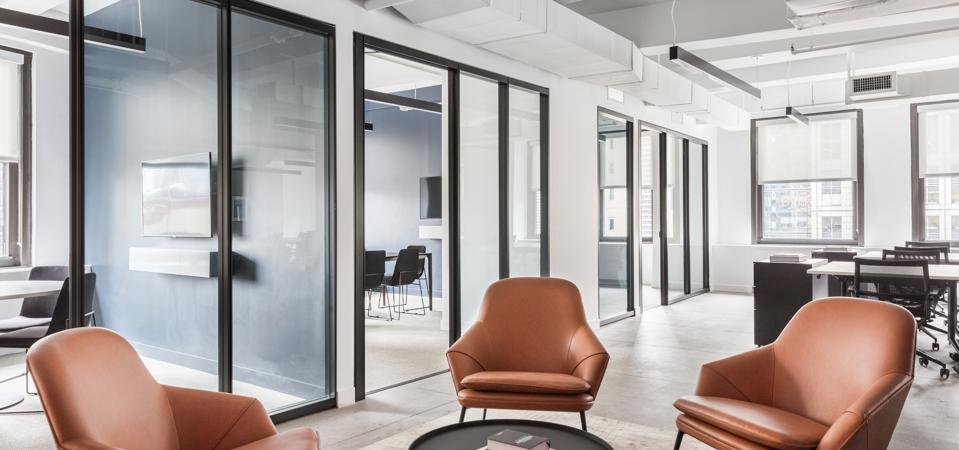
A Breather office space on Broadway in New York City, featuring furnishings positioned for social … [+]
Breather
The ways in which American employers think about work space are changing as the world slowly reopens. Companies are likely to re-evaluate both the type and amount of space they lease in the coming years. The tendency to sign long-term leases may be replaced by the search for more flexible lease arrangements. And companies seeking square footage may want spaces at once both more private and less dense than co-working environs.
Having thought a lot about these changes is Bryan Murphy, CEO of New York City and Montreal-based private and flexible workspace provider Breather, a company with more than 500 offices it makes available to customers by the hour, day, week, month or year. Murphy believes the shift in the nature of office space will have to be more dramatic than simply placing clear plexiglas dividers between desks in an open workspace.
Lingering impact
The three big workplace challenges in the short term are architecture/design, fixtures and operations, he feels. “Design is about distancing, making sure people are six feet apart,” he says. “Fixtures is about plexiglas dividers and hand sanitizing machines. Operations is where it really gets complex. As a tenant, we have to split shifts [and] screen visitors. And for commercial property owners, it’s really about adhering to the CDC guidelines.”
Once a vaccine is identified and the pandemic recedes from importance, the changes it engendered will have lingering impact. While collaboration will still be more effective in person, and people will remain social animals, the notion companies will automatically require daily office space will have long since been reconsidered. Murphy is hearing from many companies of less than 10 employees that want to eliminate offices altogether. The thing is, though, they are likely to continue to require office space some of the time.
Accelerating change
They will need space for their teams to come together once a week for a half day. Or they may require space for a day or two to accommodate clients and teams from around the country. Companies able to lease office space as needs dictate, as opposed to just leasing and sitting on that real estate, will enjoy a sizable advantage. It costs $14,800 per person to provide office space in Manhattan, Murphy notes, adding, “A lot of people are looking at that number and saying the capital can be better used in other parts of our business.”
Larger companies will have seen that working from home for some employees is a viable solution, but will still need employees in the office. Both groups will benefit, employees from more flexibility, and employers from less need for costly space and broader access to talent. Pre-COVID a New York City employer may have needed a digital market specialist, and that person had to live in New York City. “But now, the employer says lets get that digital market specialist even if that person lives in Cincinnati or Pittsburgh,” Murphy notes.
The embrace of flexible office space may be the big change reflected upon years from now as induced by the pandemic, he says. “I’ve been through a couple of these crises before, and what I find is that crises accelerate change. The great recession really drove adoption of software as a service and cloud, because of the flexibility and cost savings they provide.
“With COVID, it’s going to drive the adoption of flexible office space because of the cost savings and flexibility it provides. Same benefit. We’re talking to hundreds of companies. They’re all realizing that with the availability of on-demand space, that’s what they need. They all realize they’ll need less office space, and will need it on flexible terms.”
